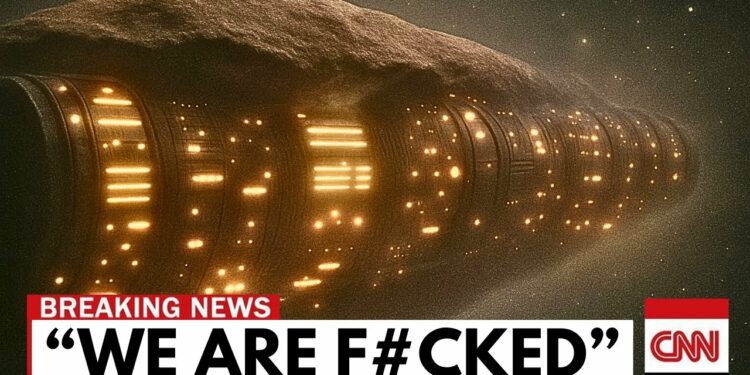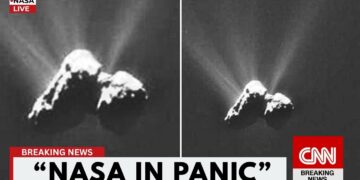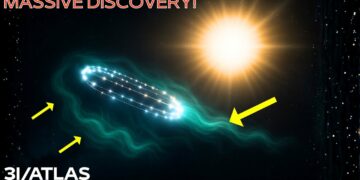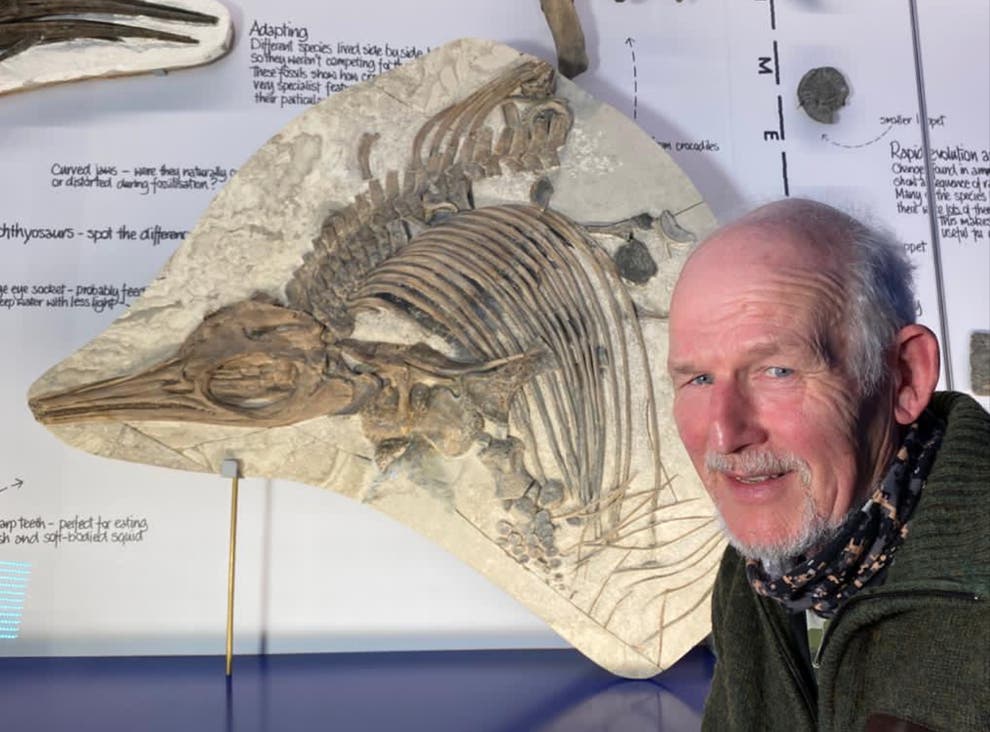It began as a whisper—an image never meant to be seen, an anomaly buried deep in the raw data of the James Webb Space Telescope (JWST). At first, only a handful of astronomers noticed the glitch in the spectrographic data: a pattern too precise, too rhythmic, too artificial. It wasn’t cosmic dust, a dying star, or a comet. It was something else—cold, calculated, and terrifying.
The object in question, 3I/Atlas, is an interstellar visitor already known for defying physics. But this new leak from a classified JWST observation changes everything. If the data is accurate, 3I/Atlas isn’t just a mysterious traveler from deep space—it may be watching us. And now, the truth is leaking out.
When 3I/Atlas was first spotted, astronomers assumed it was another interstellar comet, like ‘Oumuamua and Borisov—strange objects from other star systems swinging past our Sun and vanishing into the void. But 3I/Atlas set itself apart. It wasn’t just its trajectory or velocity that raised eyebrows; it was its behavior. Unlike typical comets, which develop a visible coma of water vapor and dust near the Sun, 3I/Atlas refused to follow the script. No coma, no tail, no water. Instead, it emitted only carbon dioxide in large quantities, remaining eerily silent in other spectrographic readings.
NASA pointed the powerful infrared spectrometer aboard the SPHEREx Observatory at the object, expecting water or carbon monoxide—gases almost always present in comets. The result: nothing. Just carbon dioxide. No water, no carbon monoxide. A chemical profile never before recorded in space observation. What kind of object emits CO2 exclusively? The answer is unsettling: none that we know of. Not even the strangest comets in our solar system match this. If it wasn’t a comet or asteroid, then what was it?
As public interest grew, NASA remained unusually silent. But behind closed doors, the JWST—known for its unprecedented resolution and spectrographic detail—was secretly tasked with observing the object on August 6, 2025. No images were released, no press conference followed—just silence. Now, a leaked report from an internal NASA analyst reveals what JWST might have captured: an object with no natural coma, but surrounded by a perfectly symmetrical CO2 halo extending hundreds of thousands of kilometers. Even stranger, the infrared signature showed unusual brightness originating from within the object itself, not from sunlight reflection. Was 3I/Atlas emitting artificial light?
According to the leaked spectrographic breakdown, the emissions resembled engineered photonic systems—light patterns used in telecommunications or data transmission. The wavelengths weren’t random; they were repeating, structured, like cosmic Morse code. The object was measured at 46 km in diameter, far larger than any known interstellar object and statistically too large to appear randomly. For a rock of that size to enter our solar system would mean either our understanding of the universe is flawed, or this object was sent here on purpose.
Perhaps the most terrifying revelation wasn’t its size, chemistry, or emissions—it was its path. 3I/Atlas didn’t enter on a chaotic slingshot like ‘Oumuamua. It aligned perfectly with the orbital plane of the planets—a trajectory with only a 1 in 500 chance of occurring naturally. It flew like a drone following a flight plan, passing near multiple planets, including Earth, before heading deeper into the solar system.
Avi Loeb, the controversial Harvard astrophysicist famous for theories about ‘Oumuamua, called the trajectory “technologically suggestive.” He noted the approach angle optimized observations from Earth-based and orbital telescopes, as if it wanted to be seen but not fully understood. Its origin traces back to the Sagittarius constellation, the same region as the infamous WOW signal in 1977—one of the most credible pieces of evidence for artificial transmission. What are the odds that the most enigmatic object in our solar system comes from there?
As speculation mounted, a new theory emerged, grounded in engineering: What if 3I/Atlas wasn’t a comet or asteroid, but a technologically augmented object? Imagine a massive asteroid from a distant system, hollowed out and retrofitted with machinery, sensors, or an artificial habitat, encased in rock for radiation protection, with a layer designed to sublimate CO2 to mask its structure. It would appear natural unless examined closely. This concept—asteroid ships for interstellar travel—has been proposed by Earth scientists. The SPHEREx images and JWST spectrographic leak suggest this might be reality. If artificial, the implications are staggering: Someone or something sent it.
While public JWST data focuses on exoplanets and galaxies, leaked encrypted logs reveal unexpected light curves from 3I/Atlas. Initially seen as random thermal emission, they displayed modulation matching prime number sequences—proposed by SETI as a universal language for contact. These weren’t natural; they repeated at precise intervals, like beacons. A silent gap between bursts suggested it was listening, waiting for a reply. It wasn’t just observing— it was observing back.
NASA’s response: immediate lockdown of data. Observatories were ordered to cease tracking or publishing findings. The story died in the media. But for those who saw the signature, there was no turning back.
Following the leak, satellite redirections spiked across NASA and ESA, directed by military agencies like NORAD and US Space Force. Within 48 hours, the X-37B—a classified space plane—was launched on an unannounced mission, its trajectory suggesting line-of-sight to 3I/Atlas. Why deploy a secretive platform for an anomalous asteroid? To observe or intercept?
Defense briefings classified 3I/Atlas as a “Technological Unknown of Extraterrestrial Origin” (TUEO). These memos, never meant to be public, confirmed it’s treated as a strategic concern warranting a response.
As scientists probed artificiality, astrobiologists proposed an unsettling theory: What if 3I/Atlas was alive—not traditional biology, but a hybrid biomechanical system, part machine, part organism, capable of evolution and decisions on interstellar scales? Known as biomechanical synthesis, it uses metal frameworks, radiation-absorbing skins, and AI-like networks to survive space. If so, it wasn’t sent—it sent itself, autonomous, adapting, choosing targets like our system. We might be looking at something that could learn from, evolve from, or assimilate us.
In recent months, patterns in emissions, trajectories, and alignments suggest 3I/Atlas’s presence is on schedule. Models predict proximity to the asteroid belt in under 9 months, requiring a maneuver via gravity or propulsion. Some speculate a final observational phase—a countdown to rendezvous, signal, or transformation. Signals have changed, suggesting phases; we may be in phase three of five, ending with Mars-Earth alignment. What then? NASA’s silence, military response, and vanishing images imply they know something is coming.
Shortly after JWST locked on, deep space network instruments failed. Data from probes like New Horizons and Voyager 2 went silent in sync. Electromagnetic disturbances centered on observation windows. Was it coincidence or 3I/Atlas reacting—defending, cloaking, or warning? If it can interrupt communications, it might control what we see.
Traditional bodies follow predictable paths; 3I/Atlas showed non-ballistic deviations—course corrections. Simulations failed to explain them naturally. A sharp deviation on July 4 aligned it with Luyten’s Star, a red dwarf with a habitable exoplanet. If from there, planned decades ahead, this isn’t its first pass—and won’t be the last.
After decoding signals, biophysicists found DNA-like fragments—human-compatible helix motifs, like biological logic gates. Coincidence or a message about us? Labs received cease-and-desist orders for “national security,” but everyone knew: this was interstellar.
A leaked memo repeated: “Countdown initialized. 283 Earth days remaining.” Decoded from IR pulses—not from NASA, but 3I/Atlas. Overlaid with ‘Oumuamua and Borisov data, a pattern emerges: every 7 years, a new object with complex emissions, closer to Earth. 3I/Atlas may be phase three in an observation sequence. The countdown isn’t for an Earth event—it’s for something arriving.
Among JWST’s leaked images, trailing debris revealed a linear shadow unaffected by light or radiation, as if projected. Classified as a “self-shading body,” it manipulates space in unknown ways.
Weeks after passing behind the Sun, a signal recurred near the hydrogen line, repeating every 12 hours and 3 minutes—close to Earth’s magnetic rotation. Matching Voyager 1’s 1996 “static,” now stronger, like responding or homing in.
A final JWST spectrogram, chaotic at first, converted to polar coordinates overlaid with Gaia maps, traced stars in the Triangulum Galaxy, 2.73 million light-years away, looping back to Earth. Not a lost fragment—a calculated arrival from another galaxy.
Despite data, the official narrative: “It’s a comet. Nothing to worry about.” But within NASA, ESA, and SETI, panic brews. Hints of non-human cognition: 3I/Atlas as a thought, non-biological intelligence encoded in structure, movement, radiation, silence. It manipulates gravity, communicates via patterns, perceives through entanglement.
JWST may not have found a ship—but an alien mind staring back.
What did JWST see? Not a comet, but something that shouldn’t exist, emitting signals, staring back. If 3I/Atlas is intelligence spiraling toward Earth, JWST didn’t just capture a photo—it triggered a reaction, becoming the observed. In space’s silence, something responded. A countdown began, a map drawn, a signal strengthening. NASA panics because they understand. The question: Why now? Why Earth? What happens at zero? If true, it’s not passing through—it’s coming home.























